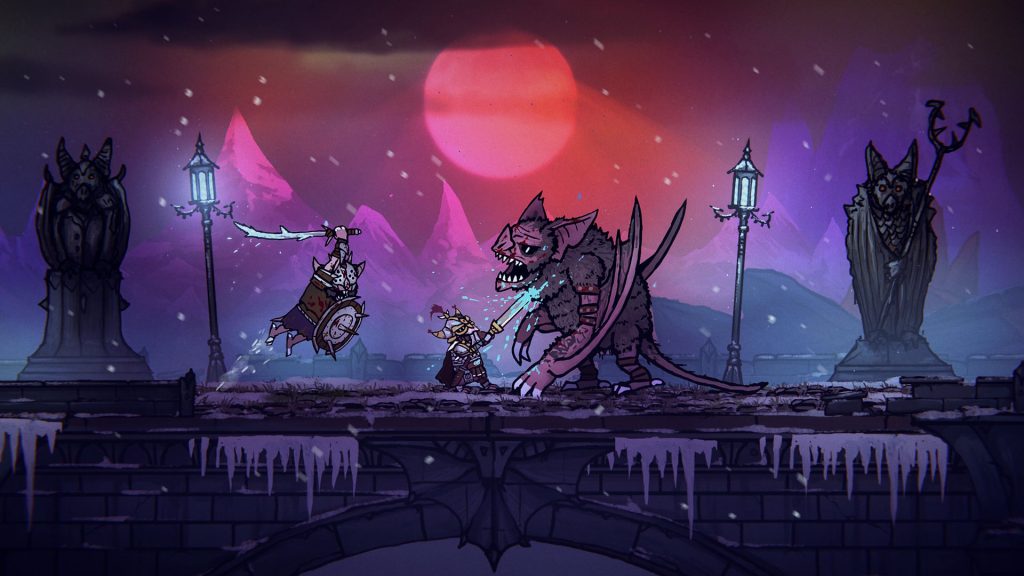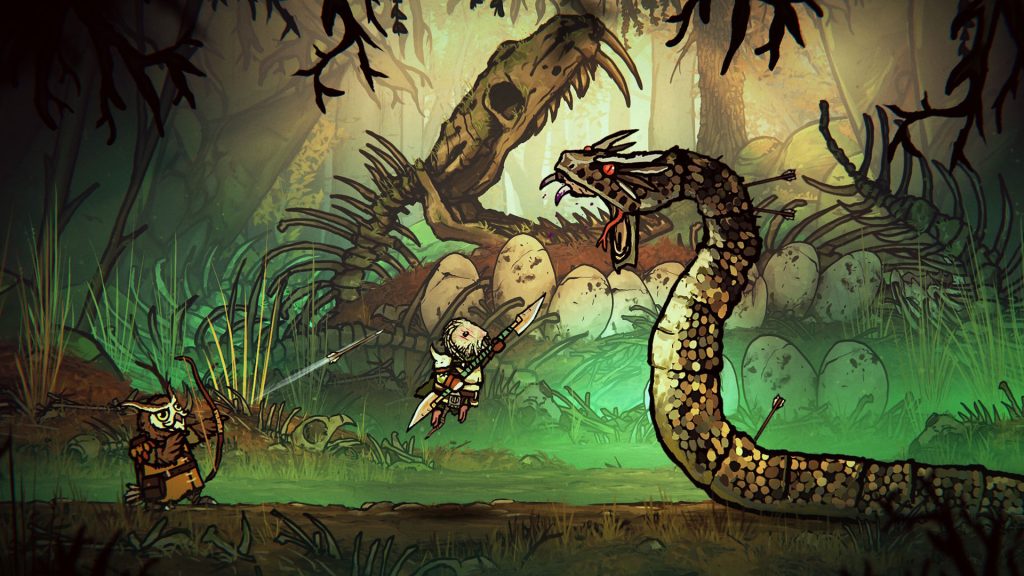The success of games like Hollow Knight and Blasphemous sparked a wave of stylized, side-scrolling Souls-like Metroidvanias. Among them, there are those that strive to carve out their own unique identities – Tales of Iron 2 being one such game. Tales of Iron 2 follows the same tried-and-true formula but introduces its own twists to offer players a familiar yet fresh experience. But that raises the question: does innovation and novelty always translate to a good gaming experience?
At first glance, Tales of Iron 2 is yet another Souls-like Metroidvania with methodical combat and challenging boss fights. However, digging deeper, you start to spot the differences: there are no stamina bars, no stat upgrades, no resetting enemy spawns, no penalties for death, and no hidden paths locked behind abilities/upgrades. Meanwhile, you can see traces of the survival genre – gathering resources through digging or looting enemy corpses, along with a fully implemented crafting system. The problem is that these survival mechanics lack depth and fail to enhance the experience in a meaningful way. For example, the whole day-night cycle and sleeping mechanic is nothing but an elaborate gimmick. Whether you start a mission at high noon or in the dead of the night, it plays out exactly the same. Also, the game could have benefited from a more traditional currency-based economy instead of its crafting system. It would have made for a more familiar progression system and better pacing.

The good news is that the most important part of the gameplay – combat – sticks to the time-tested formula, relying on familiar mechanics like attacking, dodging, blocking, perfect parries, and abilities imbued with elemental damage types such as electricity, poison, ice, and fire. The combat is extremely methodical, to the point that the slightest mistake can (and will) lead to an unceremonious death. The game does a great job of making this clear from the start, as the first two bosses drive this message home: you can’t just shuffle points around to make your character stronger – the only way to improve is to actually practice. Or, as the gaming community would have you know, “Git gud!” Having said that, the combat system does come with its own set of flaws. First, hitboxes are unforgivingly small, so your positioning requires near-mathematical precision – just a few pixels off and the attack will miss. Second, the enemies move much faster than you, giving them an unfair advantage. This feels like nothing but a blatant attempt at inflating the difficulty. Finally, fighting multiple enemies at once is never not frustrating. Imagine having to dodge a barrage of relentless, unblockable attacks from two deadly enemies while two archers are firing at you from both directions and traps are covering an annoyingly large portion of the battleground, limiting your movement. And that’s not even the worst part. The enemies do not follow predefined patterns (i.e. their moves are completely random), turning an already unpredictable situation into utter chaos. So, there are times when you have to react to seven or eight simultaneous attacks of various kinds (some are blockable, some not), all while avoiding the large traps on the ground.
On a more positive note, enemy variety – both visually and mechanically – is one of the game’s strong suits. Enemies are vulnerable or resistant to different elements, encouraging you to try out your whole arsenal instead of relying solely on your favorite weapon. However, neither enemy variety nor any of the game’s other strengths can compensate for its most glaring flaw – an absurdly outdated checkpoint/saving system. In Tales of Iron 2, you save progress by resting on benches. So, they function like the benches in Hollow Knight, right? Wrong! In Tales of Iron 2, the sole purpose of the benches is saving your progress, and there is no other way of saving other than resting on benches. To illustrate how frustrating this can be, imagine this scenario: after saving your progress, you fight several enemies, loot their bodies, talk to an NPC, craft a new weapon, fight some more enemies, and then encounter a boss you’re seeing for the first time – only to die. What happens next? You lose everything. Every fight, every item, even the NPC conversation – you must redo it all from scratch. It’s befuddling why the developers decided to implement such an outdated saving system, and honestly, it’s downright unacceptable for a game released in 2025.

Now, on to another positive aspect, the game’s narrative is surprisingly good, thanks in no small part to the warm, captivating narration delivered by none other than Doug Cockle – the iconic voice behind Geralt of Rivia. Not only that, the unique presentation of dialogue between characters – a blend of animated and still imagery coupled with animal-like sounds to represent speech – adds a certain charm to the interactions between the characters. Overall, the voice acting and sound department did a fantastic job – from the narrator’s performance to the animal and environmental sound effects, everything is done to perfection. This perfectly complements the game’s greatest strength: art design. Hand-drawn 2D visuals and detailed environments and character designs, along with stunning lighting and visual effects, such as rain and fire, make Tales of Iron 2 a pleasing sight to see.
Let’s circle back to our original question: does innovation and novelty always translate to a good gaming experience? The short answer is: no! Tales of Iron 2 could have been something special – or at least a better game. But unfortunately, innovation for the sake of innovation held it back.







